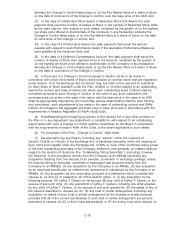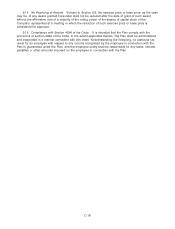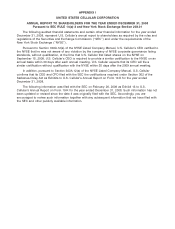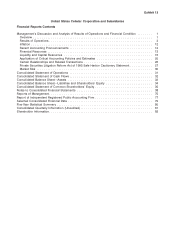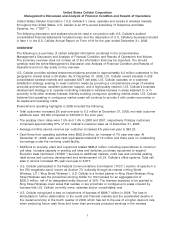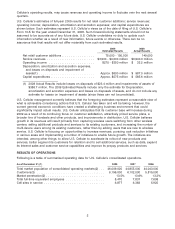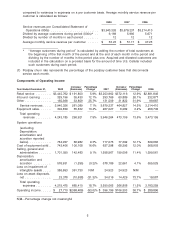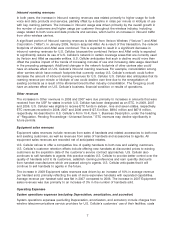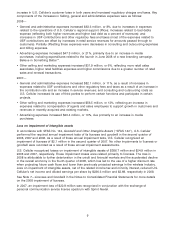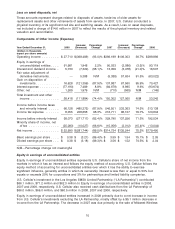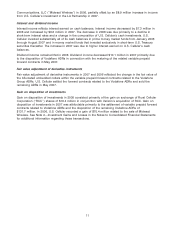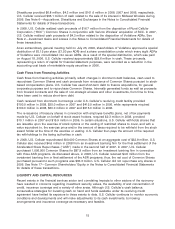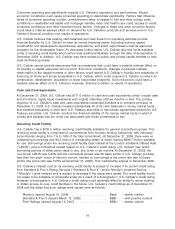US Cellular 2008 Annual Report Download - page 128
Download and view the complete annual report
Please find page 128 of the 2008 US Cellular annual report below. You can navigate through the pages in the report by either clicking on the pages listed below, or by using the keyword search tool below to find specific information within the annual report.Operating Revenues
Service revenues
Service revenues consist primarily of: (i) charges for access, airtime, roaming, recovery of regulatory
costs and value-added services, including data products and services and long distance, provided to
U.S. Cellular’s retail customers and to end users through third-party resellers (‘‘retail service’’);
(ii) charges to other wireless carriers whose customers use U.S. Cellular’s wireless systems when
roaming, including long-distance roaming (‘‘inbound roaming’’); and (iii) amounts received from the
Federal Universal Service Fund (‘‘USF’’).
The increase in Service revenues was due to the growth in the average customer base, which increased
3% to 6.2 million in 2008 following an increase of 5% to 6.0 million in 2007 and higher monthly service
revenue per customer. Monthly service revenue per customer averaged $53.23 in 2008, $51.17 in 2007
and $47.23 in 2006.
Retail service revenues
The increases in Retail service revenues in 2008 and 2007 were due primarily to growth in U.S. Cellular’s
average customer base and an increase in average monthly retail service revenue per customer.
The increase in the average number of customers each year was driven primarily by the net retail
customer additions that U.S. Cellular generated from its marketing distribution channels. The average
number of customers also was affected by the timing of acquisitions, divestitures and exchanges.
U.S. Cellular anticipates that its customer base will increase during 2009 as a result of its continuing
focus on customer satisfaction, attractively priced service plans, a broader line of handsets and other
products, and improvements in distribution. U.S. Cellular believes growth in its revenues will be primarily
from capturing wireless users switching from other wireless carriers, selling additional products to its
existing customers and increasing the number of multi-device users among its existing customers, rather
than by adding users that are new to wireless service. However, the level of growth in the customer base
for 2009 will depend upon U.S. Cellular’s ability to attract new customers and retain existing customers in
a highly and increasingly competitive marketplace. The rate of growth in U.S. Cellular’s total customer
base has slowed over time, as U.S. Cellular’s total customers increased 5% from 2006 to 2007 and 2%
from 2007 to 2008. See ‘‘Overview—2009 Estimates’’ for U.S. Cellular’s estimate of net retail customer
additions for 2009.
Average monthly retail service revenue per customer increased 3% to $46.55 in 2008 from $45.25 in
2007, and increased 7% in 2007 from $42.35 in 2006. The increase in average monthly retail service
revenue was driven primarily by growth in revenues from data products and services.
Monthly retail voice minutes of use per customer averaged 695 in 2008, 676 in 2007 and 590 in 2006.
The increases in both years were driven primarily by U.S. Cellular’s focus on designing sales incentive
programs and customer billing rate plans to stimulate overall usage. The impact on retail service
revenues of the increase in average monthly minutes of use was offset by a decrease in average revenue
per minute of use. The decrease in average revenue per minute of use reflects the impact of increasing
competition, which has led to the inclusion of an increasing number of minutes in package pricing plans
and the inclusion of features such as unlimited inbound calling, which U.S. Cellular had made a
differentiating factor in its current calling plans, as well as unlimited night and weekend minutes and
unlimited mobile-to-mobile minutes in certain pricing plans. U.S. Cellular anticipates that its average
revenue per minute of use may continue to decline in the future, reflecting increased competition and
continued penetration of the consumer market.
Revenues from data products and services grew significantly year-over-year totaling $511.7 million in
2008, $367.9 million in 2007 and $217.4 million in 2006 and represented 13% of total service revenues in
2008 compared to 10% and 7% of total service revenues in 2007 and 2006, respectively. Such growth,
which positively impacted average monthly retail service revenue per customer, reflected customers’
continued and increasing acceptance and usage of U.S. Cellular’s text messaging and picture
messaging services, easyedgeSM service and applications, and Smartphone handsets and services.
6


